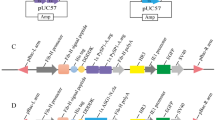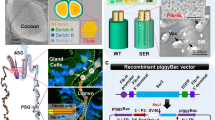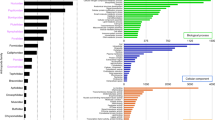Abstract
Spider dragline silk is a proteinaceous fiber with remarkable mechanical properties that make it attractive for technical applications. Unfortunately, the material cannot be obtained in large quantities from spiders. We have therefore generated transgenic tobacco and potato plants that express remarkable amounts of recombinant Nephila clavipes dragline proteins. Using a gene synthesis approach, the recombinant proteins exhibit homologies of >90% compared to their native models. Here, we demonstrate the accumulation of recombinant silk proteins, which are encoded by synthetic genes of 420–3,600 base pairs, up to a level of at least 2% of total soluble protein in the endoplasmic reticulum (ER) of tobacco and potato leaves and potato tubers, respectively. Using the present expression system, spider silk proteins up to 100 kDa could be detected in plant tissues. When produced in plants, the recombinant spidroins exhibit extreme heat stability—a property that is used to purify the spidroins by a simple and efficient procedure.
This is a preview of subscription content, access via your institution
Access options
Subscribe to this journal
Receive 12 print issues and online access
$209.00 per year
only $17.42 per issue
Buy this article
- Purchase on Springer Link
- Instant access to full article PDF
Prices may be subject to local taxes which are calculated during checkout




Similar content being viewed by others
References
Tirrell, D.A. Putting a new spin on spider silk. Science 271, 39–40 (1996).
Hinman, M.B., Jones, J.A. & Lewis R.V. Synthetic spider silk: a modular fibre. TIBTECH 18, 374–379 (2000).
Gosline, J.M., Guerette, P.A., Ortlepp, C.S. & Savage, K.N. The mechanical design of spider silks: from fibroin sequence to mechanical function. J. Exp. Biol. 23, 3295–3303 (1999).
Hood, E.E. & Jilka, J.M. Plant-based production of xenogenic proteins. Curr. Opin. Biotechnol. 10, 382–386 (2000).
Fiedler, U., Phillips, J., Artsaenko, O. & Conrad, U. Optimization of scFv production in transgenic plants. Immunotechnology 3, 205–216 (1997).
Munro, S. & Pelham, H.R. A C-terminal signal prevents secretion of luminal ER proteins. Cell 48, 899–907 (1987).
Saito, K., Keneko, H., Yyamazaki, M., Yoshida, M. & Murakoshi, I. Stable transfer and expression of chimeric genes in licorice (Glycyrrhiza uralensis) using an Ri plasmid binary vector. Plant Cell Rep. 6, 718–721 (1990).
Bevan, M. Binary Agrobacterium vectors for plant transformation. Nucleic Acid Res. 12, 8711–8721 (1984).
Fahnestock, S.R. & Irwin, S.L. Synthetic spider dragline silk proteins and their production in Escherichia coli. Appl. Microbiol. Biotechnol. 47, 23–32 (1997).
Wandelt, C.I. et al. Vicilin with carboxy-terminal KDEL is retained in the endoplasmic reticulum and accumulates to high levels in the leaves of transgenic plants. Plant J. 2, 181–192 (1992).
Prince, J.T., McGrath, K.P., DiGirolamo, C.M. & Kaplan, D.L. Construction, cloning, and expression of synthetic genes encoding spider dragline silk. Biochemistry 34, 10879–10885 (1995).
Artsaenko, O. et al. Expression of a single-chain Fv antibody against abscisic acid creates a wilty phenotype in transgenic tobacco. Plant J. 8, 745–750 (1995).
Zambriski, P. et al. Ti-plasmid vector for introduction of DNA into plant cells without altering their normal regeneration capacity. EMBO J. 2, 2143–2150 (1983).
Conrad, U., Fiedler, U., Artsaenko, O. & Phillips, J. Single-chain Fv antibodies expressed in plants. In Methods in biotechnology—recombinant proteins from plants: production and isolation of clinically useful compounds. (eds Cunningham, C. & Porter, A.) 103–127 (Humana Press, Totowa, NJ; 1997).
Acknowledgements
The authors thank K. Heinemann (Rudolstadt) for initial ideas and discussions, and I. Tiroke, I. Pfort, and C. Helmold for excellent technical assistance. This study was supported by the Bundesministerium für Landwirtschaft und Forsten represented by Fachagentur für Nachwachsende Rohstoffe (98NR050).
Author information
Authors and Affiliations
Corresponding author
Rights and permissions
About this article
Cite this article
Scheller, J., Gührs, KH., Grosse, F. et al. Production of spider silk proteins in tobacco and potato. Nat Biotechnol 19, 573–577 (2001). https://doi.org/10.1038/89335
Received:
Accepted:
Issue Date:
DOI: https://doi.org/10.1038/89335
This article is cited by
-
Membrane-based inverse-transition purification facilitates a rapid isolation of various spider-silk elastin-like polypeptide fusion proteins from extracts of transgenic tobacco
Transgenic Research (2024)
-
Engineered spidroin-derived high-performance fibers for diverse applications
Nano Research (2024)
-
The assessment of the protective impact of spidroin extract against UV-A radiation damage by using earthworms (Aporrectodea caliginosa) as a robust human skin model via macroscopic and histological observations
Environmental Science and Pollution Research (2022)
-
High mechanical property silk produced by transgenic silkworms expressing the spidroins PySp1 and ASG1
Scientific Reports (2021)
-
A marine photosynthetic microbial cell factory as a platform for spider silk production
Communications Biology (2020)



